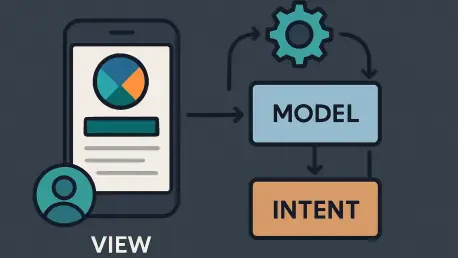In the fast-paced realm of Android development, crafting seamless and scalable user interfaces remains a critical challenge, with over 2.5 billion active Android devices relying on robust apps to deliver exceptional experiences. Jetpack Compose has emerged as a transformative toolkit, redefining how developers build UIs with its declarative, state-driven approach. Yet, the true potential of this technology hinges on choosing the right architectural pattern to structure applications effectively. This review delves into the intricacies of architectural choices for Jetpack Compose, comparing the traditional Model-View-ViewModel (MVVM) pattern with the increasingly popular Model-View-Intent (MVI) approach, to uncover which aligns best with modern development needs.
Understanding Jetpack Compose and Its Architectural Needs
Jetpack Compose stands as a cornerstone of contemporary Android UI design, offering a paradigm shift from imperative to declarative programming. Unlike older XML-based layouts, Compose allows developers to describe UI as a function of state, streamlining updates and reducing boilerplate code. This fundamental change demands architectural patterns that complement its reactive nature, ensuring that state management remains predictable and maintainable.
The significance of selecting an appropriate architecture cannot be overstated, as it directly impacts an app’s scalability and ease of testing. Patterns like MVVM and MVI have surfaced as leading contenders, each bringing distinct philosophies to the table. Their role extends beyond mere structure, influencing how teams tackle complexity in large-scale projects and adapt to evolving user demands.
A deeper exploration of these patterns reveals their alignment with Compose’s principles, setting the stage for a critical evaluation. As Android development continues to prioritize efficiency, understanding the strengths and trade-offs of each architecture becomes essential for building applications that stand the test of time.
Deep Dive into Architectural Patterns for Compose
Exploring MVVM with Jetpack Compose
MVVM has long been a staple in Android development, initially tailored for XML layouts with two-way data binding and state streams like LiveData or Flow. Its structure separates concerns by placing business logic in ViewModels, while the UI reacts to state changes. However, integrating MVVM with Compose exposes inherent mismatches, as the declarative model struggles with multiple state sources and mutable data streams.
Challenges arise from scattered state management, often leading to unpredictable recomposition cycles in Compose. Debugging becomes cumbersome due to implicit state mutations, where tracing the origin of changes is far from straightforward. Workarounds such as SingleLiveEvent for one-off actions like navigation or alerts attempt to address these issues, but they introduce additional complexity and fragility into the system.
Despite these hurdles, MVVM retains familiarity for many developers, offering a bridge from traditional Android practices. Its limitations in a Compose context, however, prompt a reevaluation of whether it can truly support the demands of modern, reactive UI frameworks without significant adaptation.
MVI and the Power of Unidirectional Data Flow
In contrast, MVI presents a disciplined framework centered on unidirectional data flow, aligning closely with Compose’s philosophy of UI as a reflection of state. This pattern organizes logic around Intents for user inputs, Reducers for state updates, immutable State for UI representation, and Effects for handling one-off actions. Such a structure ensures a single source of truth, minimizing surprises in UI behavior.
The benefits of MVI shine through in its predictability and traceability, as every state change follows a clear, explicit path. This approach not only simplifies debugging but also enhances testability, with reducers functioning as pure logic that can be validated independently of Android dependencies. MVI’s design fosters maintainability, making it easier to manage complex application states.
Adopting MVI with Compose allows developers to leverage a cohesive mental model, where the UI consistently mirrors a well-defined state. This synergy positions MVI as a compelling choice for projects aiming to maximize the benefits of declarative programming while avoiding the pitfalls of scattered logic.
Emerging Trends in Compose Architecture
The Android development community is witnessing a noticeable shift toward unidirectional data flow patterns like MVI, mirroring broader industry movements in reactive UI frameworks. This trend reflects a growing recognition that declarative tools like Compose thrive under architectures that prioritize state consistency and explicit updates over fragmented, mutable streams.
Innovative practices are shaping the landscape, with lightweight MVI libraries gaining traction for their ability to streamline reducer logic and offer debugging capabilities such as time-travel debugging. These tools reduce the manual overhead of implementing MVI, making it more accessible to teams of varying expertise levels and project scopes.
Feedback from developers and organizations further fuels the preference for MVI in intricate Android projects. As case studies and shared experiences highlight its effectiveness in managing complexity, the momentum behind unidirectional patterns continues to build, suggesting a transformative impact on architectural standards over the coming years.
Real-World Applications and Scenarios
MVI demonstrates exceptional strength in handling sophisticated states, such as pagination in content-heavy apps or seamless transitions between offline and online modes. Its structured approach to state and effect management ensures that UI updates remain consistent, even when integrating data from multiple sources, a common requirement in dynamic applications.
Industries like e-commerce and social media reap significant benefits from MVI’s capabilities, where user interactions and real-time updates demand robust state handling. For instance, managing shopping cart states or feed refreshes becomes more reliable under MVI, reducing errors and enhancing user satisfaction through predictable behavior.
Conversely, MVVM may still suffice for less demanding contexts, such as basic informational screens or small-scale apps with minimal state changes. In these scenarios, the simplicity of MVVM can outweigh the overhead of adopting a more rigid pattern, preserving resources for teams with limited architectural needs.
Navigating Challenges in Architectural Decisions
Transitioning from MVVM to MVI poses notable challenges, including a steep learning curve for teams accustomed to traditional patterns. Refactoring existing codebases to adopt unidirectional flow often requires careful planning to avoid disrupting ongoing development, necessitating incremental strategies to ease the shift.
Performance considerations also play a critical role, with MVVM risking over-recomposition due to poorly managed state streams, while MVI demands vigilance to keep state objects lightweight and efficient. Both patterns require tailored optimization techniques to ensure that Compose’s rendering mechanics do not hinder app responsiveness.
Efforts to address these obstacles include hybrid migration paths, where existing ViewModels are adapted to mimic MVI principles without a full overhaul. Additionally, advancements in Compose tooling aim to mitigate performance bottlenecks, offering developers resources to fine-tune their architecture for optimal results.
Looking Ahead at Compose Architectural Evolution
The trajectory of Jetpack Compose architectures points toward deeper integration of MVI principles within Android’s official tooling ecosystem. As the community advocates for streamlined state management, future updates may introduce native support for unidirectional patterns, reducing reliance on external libraries or custom implementations.
Speculation around enhanced library ecosystems suggests that MVI could benefit from standardized components for intent handling and effect processing, further lowering adoption barriers. Innovations in state container designs might also emerge, offering more granular control over recomposition to boost performance in complex UIs.
The long-term implications of embracing unidirectional data flow extend beyond individual projects, potentially reshaping team workflows and collaboration models. As architectural best practices evolve, Android development stands to gain from a unified approach that prioritizes clarity and consistency across diverse applications.
Final Reflections on Jetpack Compose Architecture
Reflecting on this exploration, it becomes evident that MVI carves a stronger path for Jetpack Compose, delivering unmatched predictability and scalability in complex scenarios. Its alignment with declarative principles stands out as a game-changer, while MVVM holds ground only in simpler contexts where minimal state management suffices.
Moving forward, teams are encouraged to adopt incremental migration strategies, starting with consolidating state in existing ViewModels and gradually integrating MVI’s event-driven logic. Exploring lightweight libraries for reducer support offers a practical entry point, easing the transition without overwhelming resources.
Ultimately, prioritizing architecture aligned with Compose’s core tenets promises to elevate app quality and developer efficiency. By investing in learning unidirectional patterns and leveraging emerging tools, teams position themselves to tackle future Android challenges with confidence and innovation.









